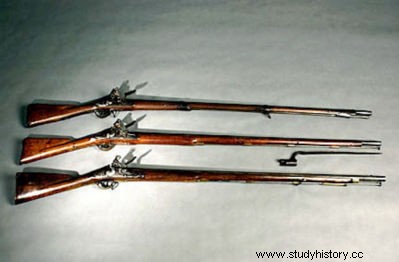
A musket (from the Italian moschetto) is a portable firearm with a long barrel, shoulder stock and lock with a matchlock or spinning wheel.
Authors and French military manuals of the 18th century clearly differentiate the matchlock musket, in use in the armies until around 1700, from the flintlock rifle which succeeded it1. However, under the influence of the English word musket, this name is sometimes used today to designate all the old black powder weapons used from the 16th to the 19th century, including flintlock rifles and rifled cap guns.
It is the ancestor of our current rifle. The musket was invented to compensate for the lack of power of arquebuses. The average length of musket barrels was 1.20 m and the bullets could have a caliber of more than 20 mm. Then gradually, the guns were reduced to about 90 cm for a maximum caliber of 18 mm.
Introduced in France after the battle of Pavia (1525), the musket was until 1650 supported on a fourquine, fork for shooting (forked iron rod to put the musket on it of a weight and a significant bulk). Infantrymen armed with a musket were called musketeers. The King provides them with a short musket, a musket used both on horseback and on foot, then an ordinary long musket only for use on foot.
The French army abandoned the musket in 1700 with the appearance of the smoothbore flintlock rifle.
